learn how
Ceramic Artist - Tiburcio Soteno Fernández - The Techniques
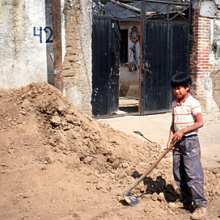
Clay is brought into Metepec from nearby clay pits. It is delivered by the truckload and deposited on the roadway outside Tiburcio's house where it is left to dry. Here, a young neighbour digs it over.
The tires of passing vehicles help to break down the clay. Tiburcio and his sons need to watch out for rain, however. When tires are wet, they carry away the clay as it turns to mud.
Later, the clay will be ground to powder and sifted through mesh wire to remove impurities and improve texture.
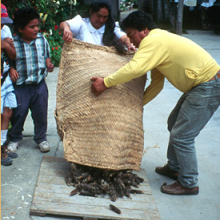
Preparing the clay is heavy, dirty work. Tiburcio mixes the sieved clay with water and plumilla - the downy fibres of bulrushes. These grow beside distant lakes, where they are harvested for sale to the potters of Metepec. According to Tiburcio, they are the only people who use plumilla in this way.
Here, Tiburcio empties out a sack-load of bulrushes in his yard. This crucially important ingredient will strengthen the clay, enabling him to construct large and complicated pieces.
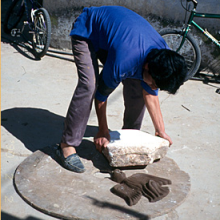
In Metepec, moulds are often used for simpler, more commercial items such as platters, ornaments, toys and garden ware. Here a male relative uses a mould to produce a hanging angel.
Tiburcio makes his own moulds, or re-uses old ones inherited from his parents. Smaller, more delicate moulds may be used to create the leaves and other repeated elements that adorn trees of life.
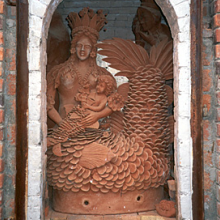
This gigantic mermaid, shown nursing her child, was entirely hand modeled. Tiburcio has used local clay, well-kneaded and mixed with plumilla. During firing, the fibres burn away.
Tiburcio used to fire his work with wood and kerosene in a circular brick kiln covered by a sheet of corrugated metal. Firings could take all night and had to be postponed during rainstorms. Now he has a gas kiln and fewer breakages.
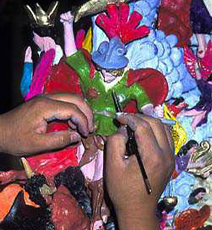
Although some Metepec pieces are left unpainted, bright colours are popular with makers and purchasers alike. The vogue is said to have started in the late 1930s or early 1940s with Diego Rivera.
During his visits to Metepec, Rivera probably introduced the brilliant but fugitive aniline colourants that came to characterize the ceramic toys and other creations of Metepec. In recent years, however, anilines have been overtaken by acrylic paints (seen here).